Here’s the rub! Chafe gear is a critical part of keeping your boat safe, but rarely does it receive much attention. Who cares about chafe gear! You should! After ground tackle, chafe gear is one of the best insurance investments for your boat. Plus chafe gear is not just for at the dock.
When we were originally shopping for chafe gear, we followed Practical Sailor’s recommendations and bought ultra chafe gear – but it’s so rigid and stiff, it’s difficult to work with. Plus it won’t fit through any of our chocks. As a result, we use it only for lines that might chafe against the dock. Since then we’ve added a variety of different types of chafe gear. It seems anytime we find a new location that needs chafe gear, we acquire something different – everything from fire hose, to garden hose, to Practical Sailor recommended to bicycle inner tube.
So what should you look for in chafe gear?
First, take a good long look at your boat. Note any place a line could rub … when lines rub anything, chafe is a possibility … maybe a probability. Make a list. Where do dock lines touch anything? Through the boat chocks, over the edge of the dock, around a dock post, etc. And don’t just look for places lines touch while you’re at the dock. What about when you’re at anchor? And what about attached to a mooring ball?
Now that you have a list of all the places lines could potentially rub and chafe, you’ll need to know what size line is in each place. And also, what size the fitting is that it will be going through, if any — chocks are a prime example.
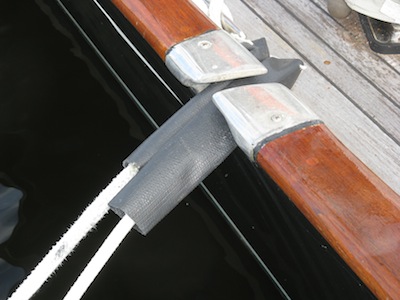
Once you know the line size and size of chock, then begin looking around for chafe gear. West Marine is a good place to start … if you look on this page, there are several possibilities:
4 Things to Look For In Chafe Gear
1. Is the chafe gear sturdy enough to stand up to whatever rubbing and chafe it might encounter? Think BIG STORM, lots of boat motion and lines rubbing a great deal, not just ordinary tide swings, although that’s important too. So, for places the lines might saw back and forth over a ragged edge (dock?) use heavier, more sturdy chafe gear. For places where lines have to bend through chocks, use a lighter more flexible chafe gear — or make sure the chocks are totally smooth and no chafe potential… although we prefer to use chafe guards through our chocks just in case.
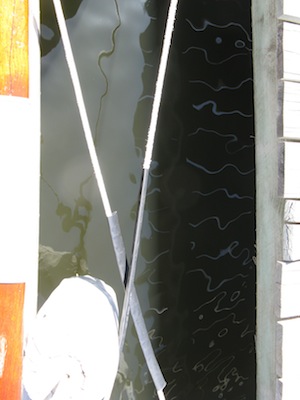
2. Is the chafe gear long enough to still be protecting the line when things are in motion?
3. Will the chafe gear fit wherever you want the protection … the most sturdy firehose in the world won’t help if it won’t fit to protect the line — mostly this involves fitting it through chocks on your boat.
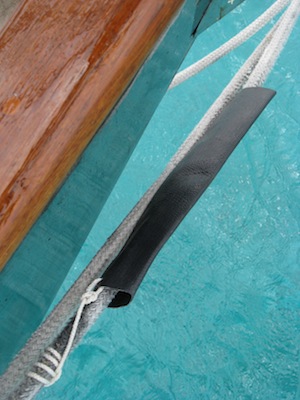
4. Is there a way to KEEP the chafe gear in place? This is critical – chafe gear isn’t useful if it slides out of place – and thus no longer protects against rubbing and chafe. Usually we can add a small line to each end and tie it securely around the line to keep the chafe gear in place.
Our Choices
Keep in mind, I mentioned we have a hodgepodge of chafe gear — right now we’re still using the heavy duty rubber red chafe gear recommended years ago by Practical Sailor for edges of docks, anywhere we can use heavy-duty totally unflexible and huge diameter chafe gear.
Our “go-to” chafe gear at the moment is something we bought at a nautical resale shop – we’re not sure exactly what it is, maybe some type of fire hose? It’s black, hard rubber or plastic, a bit flexible and fits through our chocks. We also have some bicycle inner tube that’s very flexible but not nearly as durable and wears out quickly. We actually do still have some West Marine chafe gear – the leather version and the heavy canvas.
How to Use Garden Hose or Other Hose …
Dilemma … hose is obviously totally circular, no open side to slide the line into. If at all possible, we prefer to slide it over the line from the end but you can also slit it lengthwise with a knife, position it over the line where you want it and then tie it on with small line.
Dockside Isn’t The Only Challenge…
Lines can chafe in a variety of positions, even running rigging, although that’s tough to guard against other than to watch it and replace worn lines … we have a roller furling line that’s rubbing on something that we’ll need to replace when we return to the boat this fall. So take a look around and see if you can spot any other areas that lines might be chafing … here are two of ours just to provoke thought…
Mooring ball chafe go figure … who’da thunk you’d get chafe if you’re correctly attached to a mooring ball. NOTE, I said CORRECTLY ATTACHED. This does NOT mean threading one line through the mooring ball penant and back to your boat … no no no! That line will chafe for sure and is surely asking for your boat going wandering in the middle of the night if the wind pipes up … ask me how I know this! Here’s the right way to do it and the wrong way to do it. Some mooring fields, Boot Key Harbor in Marathon/Keys is one that comes to mind, insist that you moor this way and will come around asking you to change it if you’ve done it incorrectly. They claim the incorrect way makes the line saw through not only the mooring line but their loop on the mooring ball. So to avoid damage to their mooring balls, they’re insisting on this way…
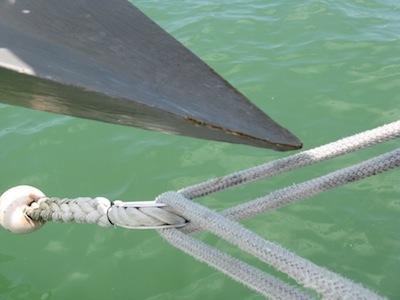
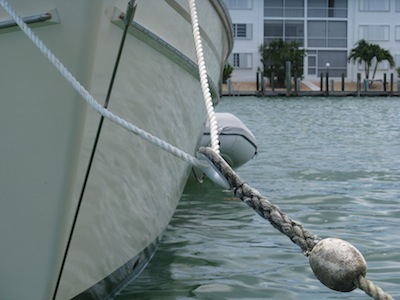
Also, because of the way our bow configuration is set up, when we swing, the mooring lines have a tendency to rub against either each other or the bow itself… it was worse, before David turned out anchor upside down on deck, they were catching on the tip of the anchor, a sure recipe for disaster.
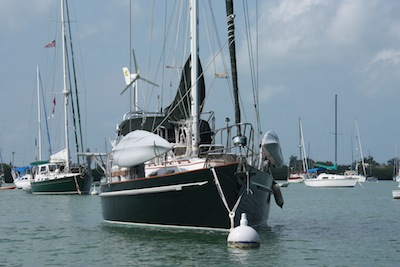
Ground Tackle Chafe… take a good long look at your ground tackle arrangement and make sure there’s no chafe going on with your snubber or other accessory ground tackle. Aboard Winterlude, we choose to anchor using a 35 pound kellet every time (just in case). The kellet line drapes over the anchor roller and has a tendency to chafe, so it wears chafe gear.

If you have other possibilities, be sure to address them ahead of time, not when you’re staring at one end of a chafed line and hopefully not adrift! Do you have another favorite type of chafe gear? Do you have other places you use it? Please leave a comment and share! THX! J
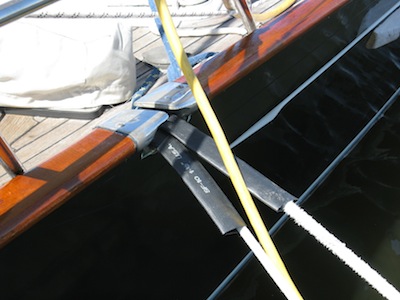










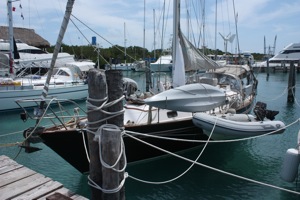


Great article, Jan. Thanks for sharing you hard-won knowledge. One point–I think you are confusing “chalk” with “chock.”
Thanks Gil! Even after thousands of miles under the keel, I’m not always clear on the terminology! 🙂
Hi Saludos desde desde Peru. Espero encontrarlos muy pronto, ya que su contenido es realmente bueno.Me parece que este es el lugar indicado para comentar sobre los incendios y los equipos mas usados del mundo. Es obvio que, casi todos sus materiales aqui no los pudiera haber le
I’ve read, seen pictures, and heard from several disjointed sources that garden hose is a bad idea. What they experienced was that during a storm, it doesn’t matter if you have double braid or three strand, they both stretch, and when they do, they build up heat. The heat causes the plastic to melt, yes, melt. That heat and melting plastic got inside the threads, which broke down the line, which caused it to come apart. I was told that the fire hose routine works well because it doesn’t build up heat when rubbed, as in what causes the chafing. I’ve used the stuff and I’ve been very happy with it, going on 15 years now. And, yea, you betcha, you gotta tie them to the line they’re protecting, I’ve seen mine walk both directions, and had to tie both ends. That’s my 2 pennies.
Kb
Thanks for the new perspective on using garden hose as chafe gear. I hadn’t heard that. Thank goodness our chafe gear this year is fire hose & the “store bought” variety of thick red stuff. Good for chafe, bad for threading through a chock, fire hose is much better. Cheers! Jan
Hi Jan
Great article.
By the way, what is your boat brand and model? It´s beautiful!
Cheers
Simon
Thanks Simon! s/v Winterlude is a 1985 (it’s her 30th birthday this year!!!) Passport 37 designed by Robert Perry. Cheers! Jan